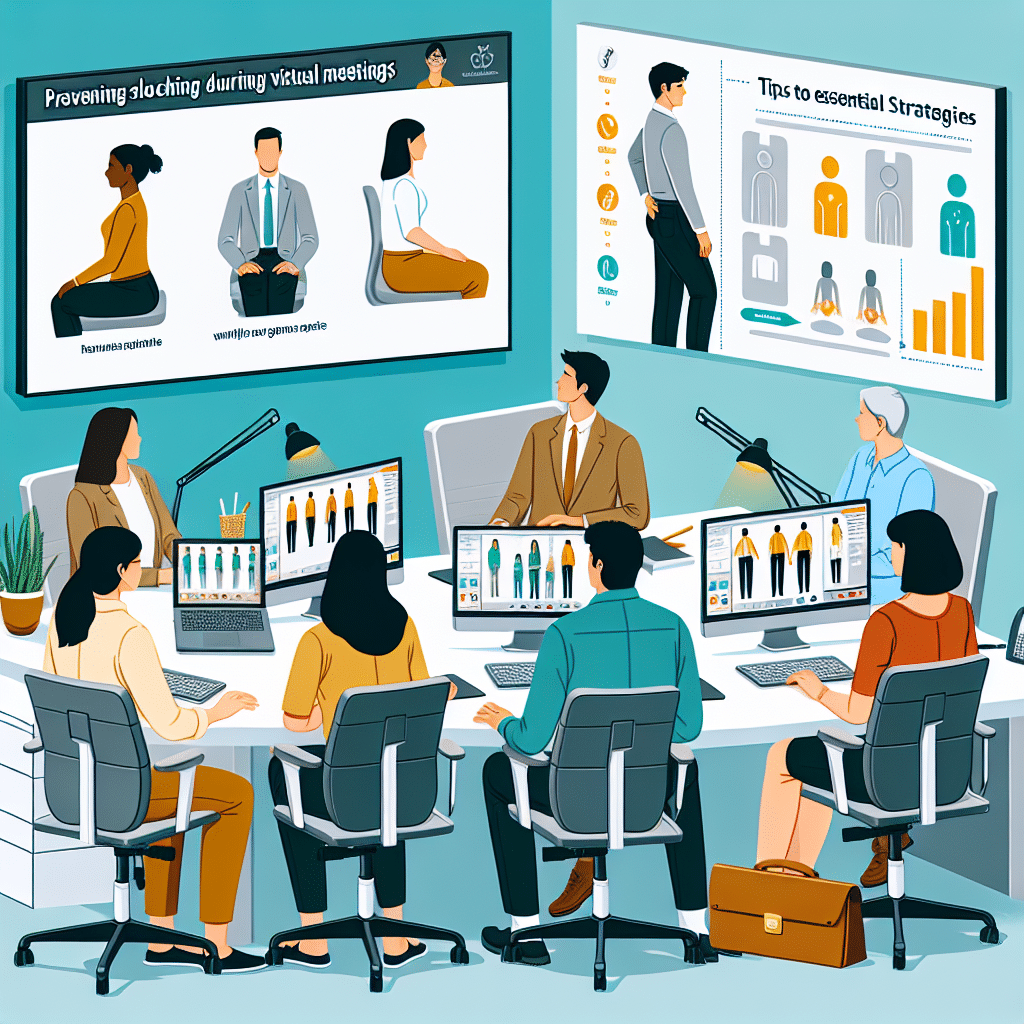Understanding Slouching in Virtual Meetings
Slouching is a common posture issue that often emerges during long hours of virtual meetings. It can lead to a variety of physical problems, including back pain, neck discomfort, and overall fatigue. To combat slouching effectively, it is crucial to adopt strategies that enhance posture and promote awareness during online interactions.
Ergonomic Setup of Your Workspace
1. Optimize Chair Height
The height of your chair plays a key role in ensuring good posture. Your feet should be flat on the floor while your knees are at a 90-degree angle. This position helps distribute your weight evenly and supports your lower back.
2. Invest in an Ergonomic Chair
An ergonomic chair provides essential support to your spine, helping to maintain the natural curve of your back. Look for chairs that feature adjustable lumbar support, seat height adjustments, and sufficient cushioning.
3. Desk Height Matters
An appropriate desk height is crucial for avoiding slouching. Your workspace should allow your elbows to remain at a 90-degree angle while typing. For many individuals, a height-adjustable desk can facilitate comfort and flexibility.
4. Optimize Screen Position
The top of your computer screen should be at eye level or slightly below. This positioning reduces the need to lean forward or look down, ultimately discouraging slouched postures. Consider using a monitor stand or a stack of books if your monitor is too low.
Enhancing Comfort: The Right Accessories
5. Use a Supportive Cushion
A lumbar roll or cushion can be invaluable for maintaining the natural curve of your spine. Placing a cushion behind your lower back can encourage a healthy sitting posture and reduce the tendency to slouch.
6. Footrest Use
If your feet do not reach the floor comfortably, consider using a footrest. This accessory supports your feet and can alleviate some of the pressure on your back, which can help you sit upright.
7. Wear Comfortable Clothing
While it might seem superficial, wearing comfortable clothing can significantly impact your meeting engagement. Restrictive clothing can create discomfort, leading to poor posture. Opt for stretchable fabrics that allow you to move freely.
Mindfulness and Awareness Techniques
8. Take Regular Breaks
Frequent breaks are essential in preventing slouching. Use the Pomodoro Technique—25 minutes of work followed by a five-minute break—to stand up, stretch, or walk around. This practice helps mitigate fatigue while encouraging better posture.
9. Self-Monitoring
During virtual meetings, make a conscious effort to check your posture. Set reminders that prompt you to sit up straight, relax your shoulders down, and keep your chin parallel to the ground. Awareness can dramatically improve your posture.
10. Use Technology Wisely
There are several apps and tools designed to help you maintain good posture. Some applications send reminders to check your posture, while devices like posture-correcting wearables can provide real-time feedback and adjustments.
Exercises and Stretches for Stronger Posture
11. Core Strengthening Exercises
Strengthening your core is vital for good posture. Engage in exercises such as planks, bridges, and abdominal crunches. A strong core supports your spine and significantly reduces the tendency to slouch during long hours of sitting.
12. Incorporate Upper Back and Shoulder Exercises
Stretch and strengthen your upper back and shoulders. Simple exercises like shoulder blade squeezes and thoracic extensions can counteract the effects of slouching. Regularly perform these exercises, especially before and after meetings.
13. Stretching Routines
Before and after virtual meetings, engage in stretching routines targeting the hips, back, and shoulders. Poses like the cat-cow stretch, chest openers, and seated twists can alleviate tension and promote better posture.
Collaboration and Engagement During Meetings
14. Use a Standing Desk or Create a Makeshift One
Incorporating standing into your meeting routine helps combat slouching. If you can’t invest in a standing desk, consider using a kitchen counter or a stack of books to elevate your laptop when attending virtual meetings.
15. Engage Actively
Involvement in discussions can naturally promote good posture. Leaning forward slightly when listening or interacting can help maintain an upright position. Engage actively with gestures or by nodding your head to show you’re participating.
The Role of Environment in Preventing Slouching
16. Natural Lighting and Airflow
Ensure your meeting space is well-lit and ventilated. Natural light can enhance mood and energy levels, reducing fatigue and the urge to slouch. If possible, position your workspace near a window to benefit from natural lighting.
17. Declutter Your Workspace
A cluttered workspace can lead to distraction and discomfort. Organize your area to improve focus during meetings. A tidy environment can also encourage more alert posture, as you’re less likely to lean forward to reach for items.
18. Use Backgrounds Wisely
Utilizing a virtual background can reduce visual distractions. Choose a simple design or a neutral backdrop that keeps the focus on you, minimizing the likelihood of shifting or slouching out of discomfort during discussions.
The Connection Between Mental and Physical Posture
19. Practice Stress Management Techniques
Stress can contribute to poor posture. Engage in stress-reducing practices such as deep breathing exercises, meditation, or mindful movement to improve your mental state. When you’re less stressed, you are likely to adopt a healthier posture.
20. Establish a Routine
Establish consistent meeting habits that encompass good posture. Create a pre-meeting routine that includes stretches, tech checks, and mindfulness activities. This routine can set a positive tone that encourages better physical habits.
Regularly assessing your seating arrangements, incorporating ergonomic tools, and committing to both physical exercises and mental strategies will not only enhance your comfort during virtual meetings but also improve your overall engagement and productivity. By prioritizing posture, you can enhance your meeting experience significantly.
